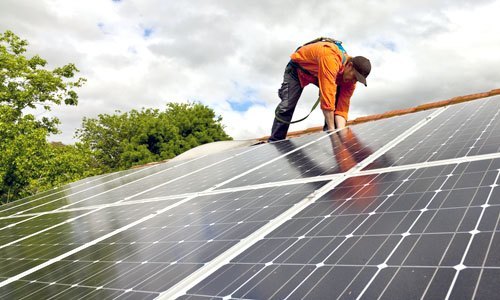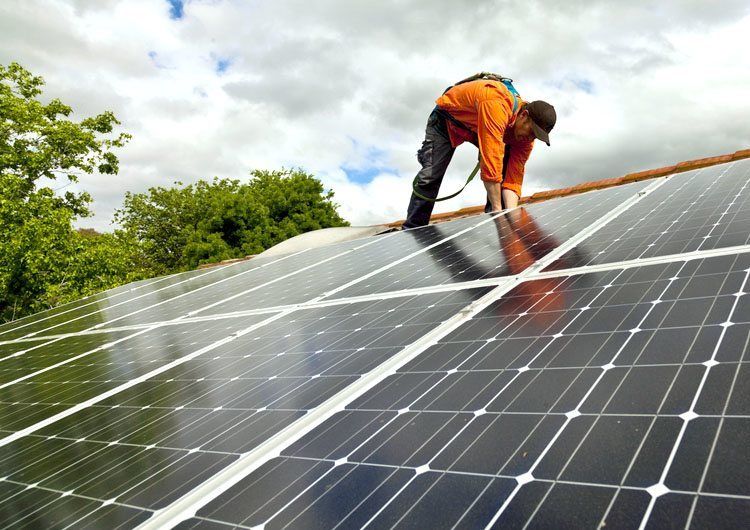
This U.S. Town Plans to Disconnect From the Grid and Go 100 Percent Renewables

Nassau, New York, a town of 5,000 people just outside of Albany, New York, plans to disconnect from the electrical grid. Last week, the town board voted to get 100 percent of its power from renewables by 2020. The town is making the move both as a way to “increase its reliance on renewable sources of energy and to gain some energy independence,” Politico New York reported.
“If all goes as planned, within the next four years, all six of the town buildings will be disconnected from the grid,” said Nassau Supervisor Dave Fleming. The rest of the town is developing a plan to get all of its power from renewable sources in the next four years.
“It’s not the be-all to end-all for what we should be doing as a state and a nation, but it’s a good first step,” he said. “From a practical perspective, it’s possible,” he added. “We have a lot of ‘people resources’ in our community.”
The town plans to use a combination of rooftop and ground-mounted solar, wind turbines and methane-capture from the landfill to generate its energy.
Though the tiny town’s transition to renewables may not have the impact of, say, New York City going fossil-fuel-free (Mayor Bill de Blasio has pledged for municipal operations to run on 100 percent renewable energy before 2050), it’s just one of many cities and towns around the world making the transition.
New York State even has a program to help municipalities make that transition. Spokesman Jon Sorensen told Politico:
“The state Department of Public Services wants more towns to follow Nassau’s lead. Through its Reforming Energy Vision (REV) initiative, the Cuomo administration is actively working to help municipalities—especially towns and schools—move toward getting a significant portion of their power from renewable resources. REV is designed to make the energy grid more efficient and increase its reliance on renewables, and it is intended to give consumers more choices than they have now. This is exactly the kind of thing REV is hoping to encourage. Smaller, cleaner power systems are less costly and cleaner alternatives to the bigger power stations that have made up the power grid.”
And it’s not just New York. More than 350 U.S. state and local elected officials from nearly every state signed a letter during the Paris climate conference calling for 50 percent clean energy by 2030 and 100 percent clean energy by 2050.
Today, San Diego, California’s city council is voting on a proposed plan to get 100 percent of its energy from renewable sources by 2035. It’s expected to pass. Vancouver, Las Vegas and other major cities around the world want to go 100 percent renewable, too. Hawaii pledged to go 100 percent renewable by 2045—the most ambitious standard set by a U.S. state thus far. Several other islands, including Aruba, Belize, St. Lucia, Grenada, the British Virgin Islands, the Bahamas, Turks and Caicos, and San Andres and Providencia have pledged to go 100 percent renewable, as well, through the Ten Island Challenge, created by Richard Branson’s climate group the Carbon War Room.
Several countries around the world have hit impressive benchmarks for renewables in just a few short years. And many places have already made the transition to fossil-fuel-free electricity. Samso in Denmark became the world’s first island to go all in on renewables several years ago. Most recently, Uruguay, three U.S. cities—Burlington, Vermont; Aspen, Colorado; and Greensburg, Kansas—along with Kodiak Island, Alaska, have all made the transition.
Greenpeace and researchers at Stanford and UC Berkeley have laid out plans for every state in the U.S. to adopt 100 percent renewables and a Greenpeace report published in September posits the world can achieve 100 percent renewable energy by 2050. Mark Jacobson, one of the researchers from Stanford, said the barriers to 100 percent clean energy are social and political, not technical or economic.
The International Energy Agency released a report in October that found a quarter of the world will be powered by renewables by 2020. And a report from the International Renewable Energy Agency found that the transition to a sustainable energy future by 2030 is “technically feasible and economically viable.”
YOU MIGHT ALSO LIKE
Town Rejects Solar Farm Amid Fears it Would ‘Suck Up All the Energy From the Sun’
Solar Powered ‘Farm from a Box’: Everything You Need to Run an Off-Grid Farm

 233k
233k  41k
41k  Subscribe
Subscribe 
